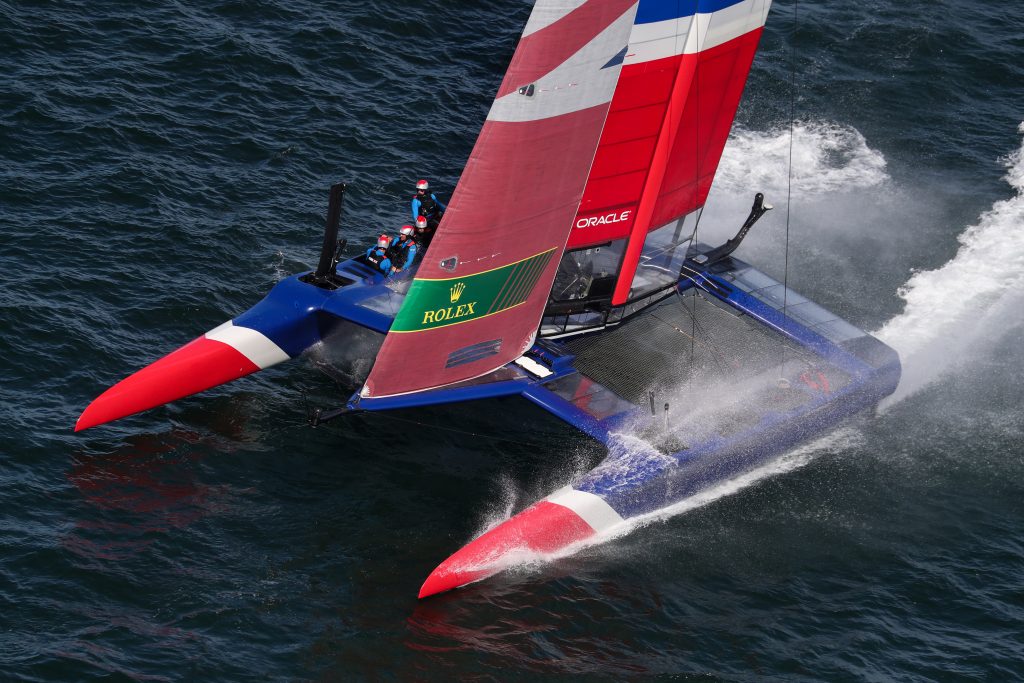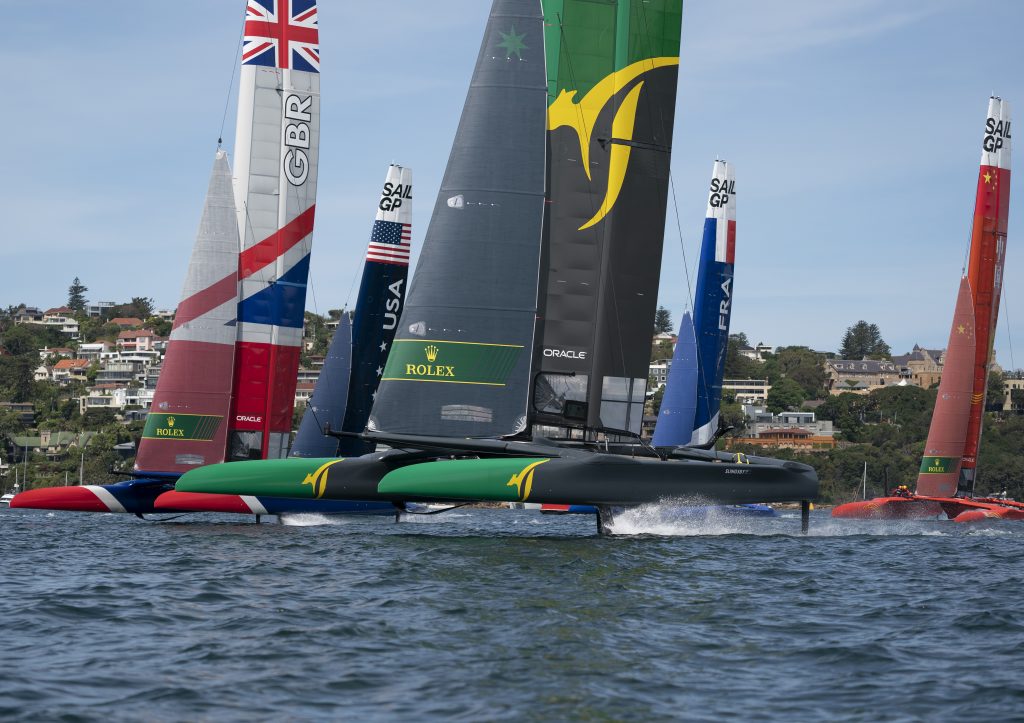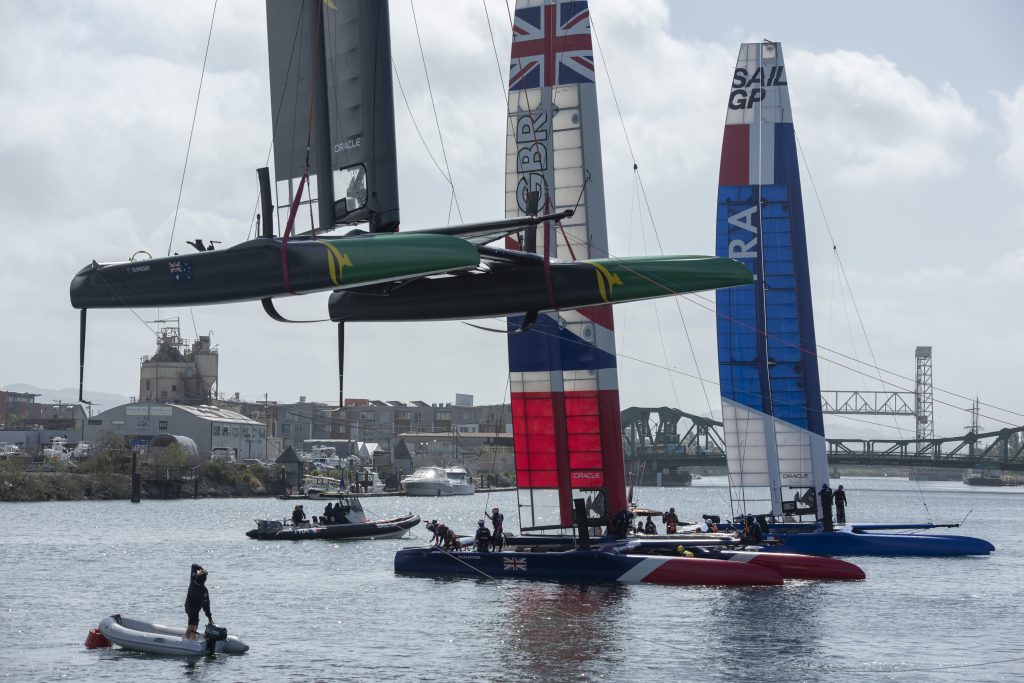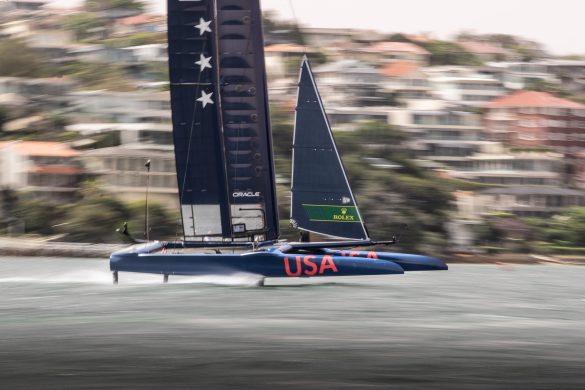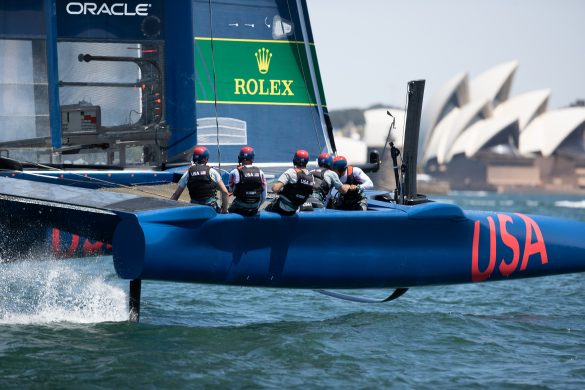Paul Standbridge gives us some insight into his on-water operations role for SailGP during the 2019 season.
“I have long been involved in yacht racing, race team management and on-water operations, so I was pleased to be invited to join the SailGP series’ race management team as part of their on-water operations.” Says
The team
The on-water operations team consists of about 20 people, six of whom lay marks from three rigid inflatable boats (RIBS).
Another six are course marshals, who mark the perimeter of the race course that the spectator boats have to stay out of. Within this course is an invisible electronic boundary that is set by the race committee. A visual boundary, for the benefit of the public, is marked by large inflatable buoys. This can incorporate a lighthouse or other landmarks.
The race committee is made up of four people operating from an anchored committee boat. They communicate with the chief course marshal and the six course marshals via a private radio channel. The race committee sets the course by
electronic means using equipment that measures wind direction and speed, etc. to determine the angles and positions of the marks for those particular conditions. They also manage the starts, record the finishing results and electronically govern the course when the wind changes.
If there is a change to the course, they will communicate this to the chief course marshal (I am course marshal number two) and he will change his marshalling perimeters to fit the new course. There are also two umpires, who act as on-water judges to avoid long protest meetings after racing. They follow the race boats around the course in very fast RIBs to ensure that no racing rules are broken. If they are, this is indicated with a flag so that the offending boat crew knows to do a penalty there and then. If they don’t, they are disqualified from the race. The remaining six people are volunteers who help lift and drop the buoy anchors.
- Great Britain SailGP Team skippered by Dylan Fletcher practice ahead of the first race on day two of competition. Event 1 Season 1 SailGP event in Sydney Harbour, Sydney, Australia. 16 February 2019. Photo: David Gray for SailGP. Handout image supplied by SailGP
- Australia SAILGP Team skippered by Tom Slingsby moves away from the pack on day two of competition. Event 1 Season 1 SailGP event in Sydney Harbour, Sydney, Australia. 16 February 2019. Photo: Bob Martin for SailGP. Handout image supplied by SailGP
The prep
Seven days before the start of the event, an advance party of six people arrives. They have access to the RIBS in the containers. They pull them out, do some maintenance, service engines, and do the normal checks and balances on the ground tackle. I arrive with the second party of six people, three days before the regatta. By then the RIBS
should have been set up, ready to launch.
There are 12 people who launch, maintain and prepare the 20 marks and ground tackle. The marks are extremely difficult to manoeuvre as they are big and bulky. They need to be inflated and taken to the water’s edge or wherever is suitable, along with their anchors, long chain and anchor line. Each mark has a tracker with a float attached to allow it to be positioned slightly away from the mark. It has its own weight to make sure it stands upright. These trackers are used by the committee to set the spectator boundary.
The day after I arrive, and once the RIBS and marks are set up, we do a dry run with all the marshal RIBs, volunteer boats and racing boats. It’s used as an informal practice day by all the sailing teams. It’s also used to make sure that the volunteers can drop the buoy anchors properly and quickly, that they are strong enough to pull them up (this is all done by hand – there is no windlass powering the picking up and dropping of anchors) and that they are confident and capable of doing the job.
Each marshal RIB carries a course marshal and a volunteer, and each of these RIBS must manage a volunteer boat with two people allocated to them. I manage the volunteers and tell them what I need them to do. The following day is an informal practice day, which is like a full dress rehearsal – a simulated race day.
- Shore crew and sailors prepare the F50s for the media practice day. Practice race day, Event 2, Season 1 SailGP event in San Francisco, California, United States. 30 April 2019. Photo: Chris Cameron for SailGP. Handout image supplied by SailGP
The racing buoys
The racing marks are unmanned and are shaped like a square box, with an anchor in the middle. Each mark has a designated RIB responsible for it. Each anchor has a remote control to manoeuvre the marks according to a specific GPS position. One of the toughest things to get right is setting a race course defined by a TV broadcast slot. The races are normally around 17 minutes each. If, during the race, the course has to be adjusted to allow for the wind increasing or dropping, thus making a race longer or shorter than the time allocated to the broadcast, then there is a lot of jostling to move the buoys to accommodate this new course.
For this reason, the guys who lay the marks are highly stressed. They often have to motor in quickly and move the marks by nudging or towing them with their RIB and drop them in their new positions before the racing boats arrive at that mark. They are highly skilled and experienced in this role.
The planning
The course marshals start each day with a morning meeting. They discuss the plan for the day, give new instructions if necessary and share feedback from the previous day. This could be about what improvements can be made to systems, etc. so that the regatta runs smoothly.
Final checks for the RIBS include:
• starting the engines to make sure they are in working order
• putting up their designated flags (each boat is given an ID flag according to their responsibilities on the water: marshals, media, umpires, VIPs, etc. and these flags need to be flown at all times)
• topping up the RIBs pontoons with air
• checking the navigation system to make sure that it is working properly and that the boats are receiving a signal from the race committee (the B&G chartplotter)
• doing electronic checks to ensure the whole fleet is visible on the chartplotter (each racing boat has a tracker so that the boats can be seen on the course by spectators who are following them digitally)
• doing a radio check (they make use of both VHF and UHF – private channels – and they have a few different frequencies for marshals and media, for example)
• checking that the marks are fully inflated
• preparing the ground tackle, rope, chasing and anchors
• checking that the buoy trackers are operational and able to transmit signals.
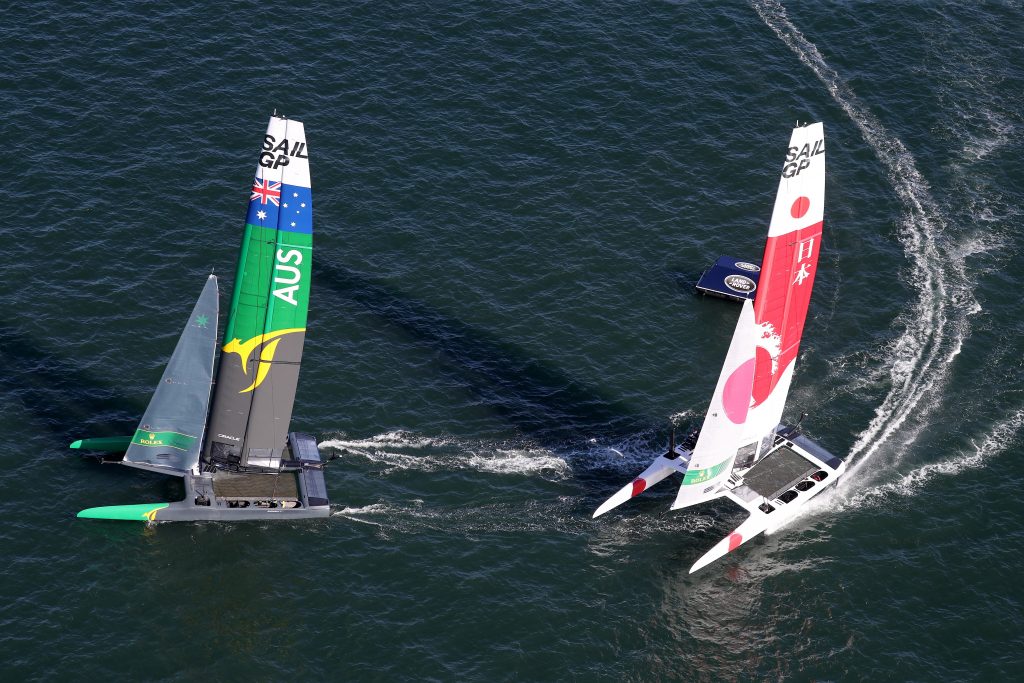
The briefing
Briefings are held in a classroom for VIPs, superyacht captains and volunteers. They even show gory pictures of bad accidents and of people breaking the rules on a race course.
There was an incident a few years ago in France where a course marshal didn’t go to a briefing. He felt that he didn’t need to because he knew the area and the waters well, and his boat got chopped in half by a high-speed yacht on the race course. Luckily no-one was killed, but someone was badly injured. It’s a strong reminder to us all of what can happen very quickly.
The timing
Depending on the race course, the marshals will set off four hours before the race start. All the RIBs rendezvous on the water at an agreed point and do a final check-in with each other and the race committee. The crews are then issued with packed lunches, antennas, radios and final instructions.
They then head to the race course area and get ready to implement lockdown, which means take control of the racing area, one hour before the start. Marks are laid according to the coordinates set out by the race committee. The marshal boats start warning people about the lockdown 1 hour and 30 minutes prior to the start. Full race lockdown lasts until 2 hours and 30 minutes after the race. Some people fight a bit with us, but I ask them politely and advise them to move.
We have to maintain zero tolerance. If one person goes over the perimeter line then everyone else follows.
One hour before the start, the racing area has to be cleared and we begin policing the perimeter. By now, the spectator boats have started to assemble. On the boundary I ride up and down to a volunteer boat to create a straight physical line with the wash, which they have to stay behind. I stay on the inside of the line. It’s a dangerous place to be. If you are caught on the wrong side of the perimeter and a race boat comes at you at 50 knots an hour, it will chop people to pieces.
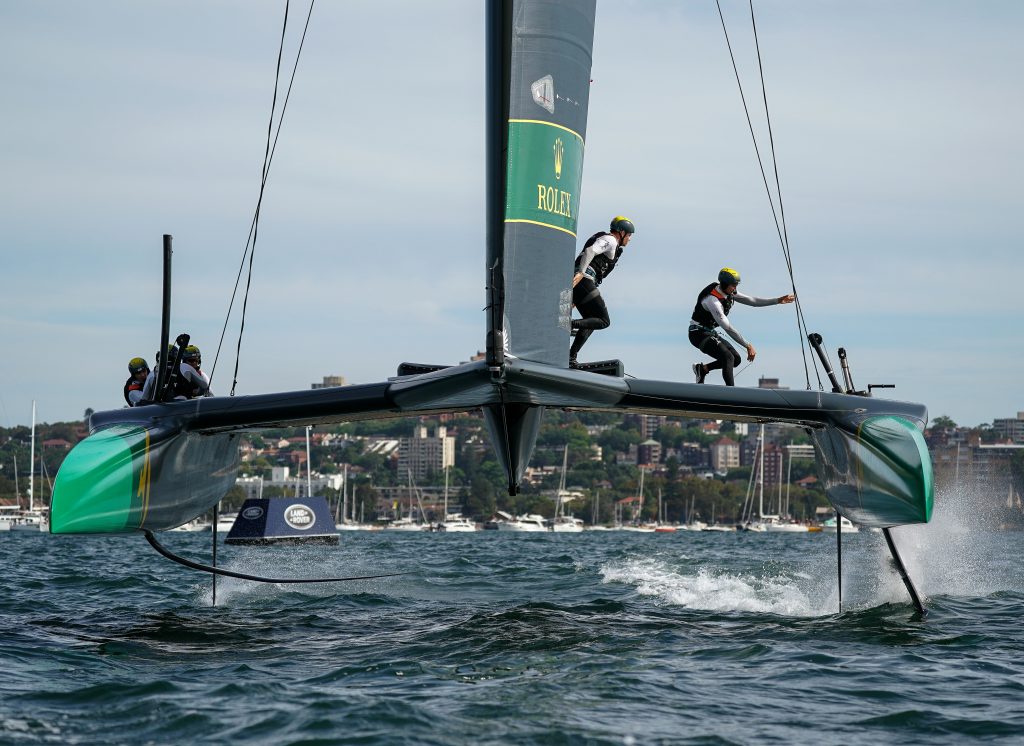
Australia SAILGP Team skippered by Tom Slingsby on their way to winning the event on day two of competition. Event 1 Season 1 SailGP event in Sydney Harbour, Sydney, Australia. 16 February 2019. Photo: Bob Martin for SailGP. Handout image supplied by SailGP
The spectators
VIPs and superyachts are allowed to be on the inside of the boundary. Each has to be within a square box in a designated area, which is marked off by coordinates. The superyachts pay for the privilege of being able to fly their VIP flag and be up close to the racing and close to the actual course. The superyacht captains would have gone to the morning briefing, and they would also have a chart of the area and instructions.
There are also VIP guests in RIBs on the inside of the course. Those drivers also have their instructions of where they can and cannot go – but they pretty much have the rule of the course and can go where they please. This is normally held for race principles Larry Ellison and Russell Coutts, who own the SailGP series, and who may have VIP guests with them.
Each SailGP race boat has more than one RIB. These follow their race boat as support crafts but only the one flying the
relevant flag will be given access to anywhere on the course. Sometimes the race area’s invisible line and the spectator’s line can coincide, so it’s absolutely critical to have the electronic markers in the right place and that no-one crosses the line within a metre of the race course.
The wrap-up
Once the race is over, the marshals need to maintain the race course boundaries because the race boats are still doing 30
knots (they finish on a downwind leg at full pace so they can’t just stop the boat). The marshal boats make a ‘gate’ to allow the race boats to get off the course to head back to the marina/harbour or race village.
We try and hold the line for about 15 minutes until the chief course marshal gives the instruction to drop the course flags
indicating that the race area is now open to all. We might even help escort the race boats back to the dock or escort a superyacht out of its designated area, and we could be under instructions from the coastguards to assist with other boats still on the course. The race management team will then direct the marshals to break down the box (course).
The roadshow
Any big event that moves from one destination to another is a travelling roadshow likened to the F1 racing circuit. Boats and equipment arrive, races are sailed, and then the road show is packed up and moved on to the next venue. It takes a big sum of money to make this event happen. Even so, it is run on a very lean, but fair budget, hence the race management team only comes in at the last minute for the minimum amount of time needed to make the event run smoothly.
There is no free-for-all. We work hard, we stick to the budgets and we look after the equipment to avoid unnecessary
maintenance or replacement of equipment or gear. By ensuring that the series of events is run on a reasonable budget, and that no unnecessary expenses are incurred, we can ensure that the event/series will be able to continue for many years, creating regular work.
Larry Ellison and Russell Coutts, the founders of SailGP, ultimately want the event to stand on its own two feet through sponsorship, and not have to rely on billionaire owners. The SailGP model should grow the number of entries and therefore be viable to sponsors as costs are kept in check.


